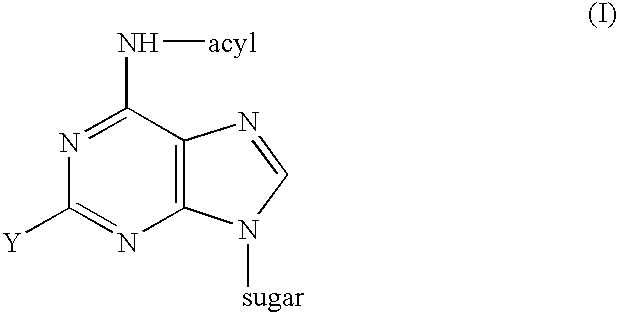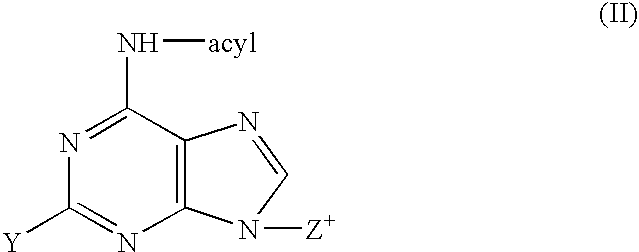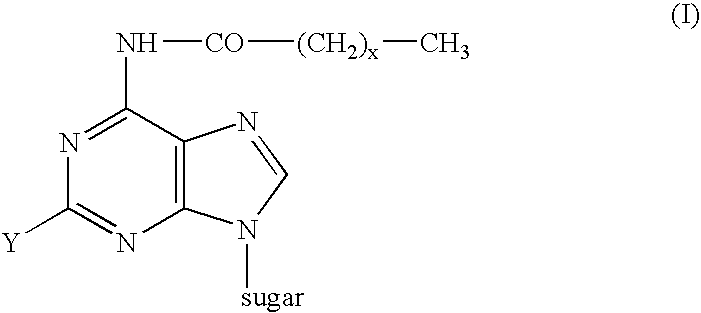Process for the preparation of 9-beta-anomeric nucleoside analogs
a technology of 9-beta-anomeric nucleosides and process, which is applied in the field of process for the preparation of 9-beta-anomeric nucleoside analogs, can solve the problems of inability to achieve the purification of 2′-deoxy nucleosides on a large scale, and achieve the purification of two very similar positional isomers
- Summary
- Abstract
- Description
- Claims
- Application Information
AI Technical Summary
Benefits of technology
Problems solved by technology
Method used
Image
Examples
example 1
6-Heptanoylamido-9-(2-deoxy-3,5-di-O-p-toluoyl-β-D-erythro-pentofuranosyl)-purine
[0017]1. The heptanoylamido purine 1 (4.94 g; 20 mmol) was suspended in anhydrous THF (55 ml). The mixture was mechanically stirred and cooled to −35° C. under an atmosphere of nitrogen. To the stirred mixture at −35° C. was added 0.5M solution of KHMDS in toluene (40 ml; 20 mmol) dropwise over 5 minutes. The mixture was stirred at −35° C. for 45 minutes; then slowly warmed to room temperature and stirred at room temperature for 30 minutes. Dry powdered 1-chloro-2-deoxy-3,5-di-O-p-toluoyl-α-D-erythropentofuranose (8.58 g; 22 mmol) was added to the stirred mixture portionwise over 10 minutes and the mixture was stirred at ambient temperature for 3 h. The solution was concentrated in vacuo and the residue was taken in methylene chloride (150 ml). The organic layer was washed with water (1×100 ml); 5% NaHCO3 solution (1×50 ml); brine (1×50 ml); dried (MgSO4); filtered and stripped to obtain a crude residue...
example 2
2-Chloro-6-heptanoylamido-9-(2-deoxy-3,5-di-O-p-toluoyl-β-D-erythero pentofuranosyl)purine
[0019]a. 2-Chloro-6-heptanoylamido purine 2 (2.81 g, 10 mmol) was suspended in anhydrous THF (28 ml). To the mechanically stirred mixture under nitrogen atmosphere at −30° C. was added 0.5M solution of KHMDS in toluene (20 ml; 10 mmol) and the mixture was stirred at −30° C. for 30 minutes. The mixture was warmed to room temperature and stirred at room temperature for 30 minutes followed by addition of 1-chloro-2-deoxy-3,5-di-O-p-toluoyl-α-D-erythropentofuranose (3.90 g; 10 mmol) portionwise over 5 minutes. The solution was stirred at ambient temperature for 2 h. The solution was concentrated in vacuo and the residue was taken in methylene chloride (100 ml). The organic layer was washed with water (1×50 m), 5% NaHCO3 solution (1×40 ml); brine (1×40 ml); dried (MgSO4); filtered and stripped to obtain a residue. This material was purified on a silica gel column (2.5×35 cm) using ethyl acetate: hex...
example 3
6-Heptanoylamido-9-(3-deoxy-2,5-di-O-benzoyl-β-D-erythropentofuranosyl)purine
[0021]1. 6-Heptanoylamidopurine 1 (2.47 g; 10 mmol) was coupled with the 2,5-di-O-benzoyl-3-deoxy-β-D- or L-erythro-pentofuranosyl chloride (3.60 g; 10 mmol) as described for example 1 except the reaction mixture was warmed at reflux temperature for 6 h to obtain after silica gel column purification, the title compound 2.07 g (37%); m.p. 72-74° C. 1HNMR (CDCl3): δ 9.07 (br s, 1H, NH), 8.63 (S, 1H, C8—H), 8.22 (S, 1H, C2—H), 6.25 (d, 1H, J1,2=1.2 Hz; C′1—H). Analysis calculated for C31H33N5O6 (571.629): C, 65.13; H, 5.81; N, 12.25. Found: C, 64.90; H, 5.80; N, 11.73.
6-Amino-9-(3-deoxy-β-D-erythropentofuranosyl)purine (3′-Deoxyadenosine; cordycepin) 11a
[0022]2. A suspension of 6-heptanoylamido-9-(3-deoxy)pentofuranosyl purine (product of 3a; 1.8 g; 3.15 mmol) was deblocked with sodium methoxide-methanol as described for example 1 to obtain 3-deoxyadenosine. The crude product was crystallized from boiling wate...
PUM
| Property | Measurement | Unit |
|---|---|---|
| temperature | aaaaa | aaaaa |
| temperature | aaaaa | aaaaa |
| temperature | aaaaa | aaaaa |
Abstract
Description
Claims
Application Information
 Login to View More
Login to View More - R&D
- Intellectual Property
- Life Sciences
- Materials
- Tech Scout
- Unparalleled Data Quality
- Higher Quality Content
- 60% Fewer Hallucinations
Browse by: Latest US Patents, China's latest patents, Technical Efficacy Thesaurus, Application Domain, Technology Topic, Popular Technical Reports.
© 2025 PatSnap. All rights reserved.Legal|Privacy policy|Modern Slavery Act Transparency Statement|Sitemap|About US| Contact US: help@patsnap.com



